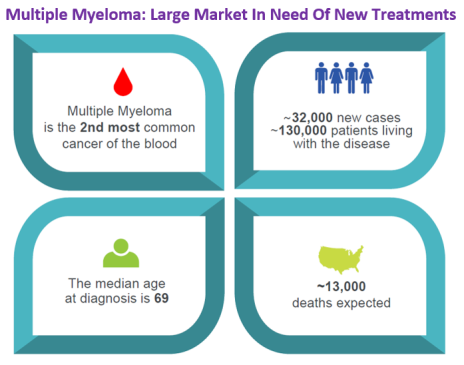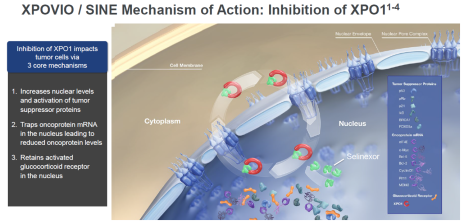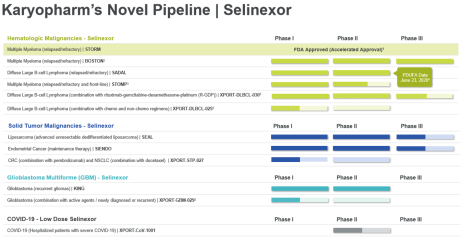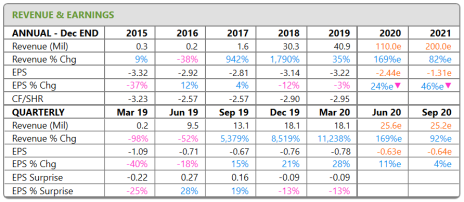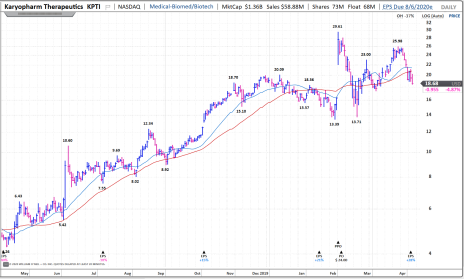This month we’re adding a high-growth biotech name that has just begun to commercialize a unique compound for fighting aggressive cancers and other diseases including, potentially, COVID-19.
The company just began booking revenue from its first cancer treatment. That launch significantly de-risks the stock and raises the potential for future approval of the same compound for other indications.
The stock has retreated lately because prescription sales were curbed during the COVID-19 outbreak. This should be a temporary dip as there are many potential stock-moving catalysts coming this year. We’re hoping to sneak in and buy the dip on this high-potential name.
All the details are inside this month’s Issue. Enjoy!
Cabot Small Cap Confidential 252
[premium_html_toc post_id="204741"]
The Big Idea
While the world is laser-focused on potential treatments and vaccines for COVID-19 there are still other other life-threatening diseases for which we need better treatments.
Take, for example, multiple myeloma, the second-most common blood cancer in the U.S. The market for treatment options is huge and growing toward $20 billion by 2024.
There are over 130,000 patients living with the disease and 32,000 new cases pop up each year.
While treatment options are improving, especially among non-chemotherapeutic agents, there is no cure and almost all patients eventually relapse and pass away from the disease.
Then there’s Non-Hodgkin Lymphoma (NHL), a group of related cancers that affect the body’s immune system. NHL accounts for 4% of all cancers. Each year roughly 77,000 people in the U.S. will be diagnosed and 20,000 will pass away. The most common form of NHL is Diffuse large B-cell lymphoma (DLBCL), which has a roughly 40% mortality rate.
Solid tumors also claim their fair share of lives. Liposarcoma, endometrial cancer and glioblastoma, just to name a few, take too many people too soon.
The company I’m profiling today is developing a special kind of compound that appears to extend lives in all these indications, and more.
Perhaps most interesting about its drug candidates is how they work, which is essentially by regulating the doors of cells to keep bad actors out and good actors in.
The end result is more beneficial firepower in the cell, not only to fight cancer, but potentially a wide range of neurodegeneration, inflammation, autoimmune diseases, and viruses.
Not only does this company have one drug approved for an aggressive form of multiple myeloma, it’s currently evaluating the same compound, in much lower dosage, for severe cases of COVID-19! I find that range of potential benefits astounding.
To make the story just a little bit sweeter, there is only one other known company progressing a drug candidate with a similar mode of action.
As always with biotech, the risks are high but so are the potential rewards. Take it slow, average in and expect a wild ride.
The Company
Karyopharm Therapeutics (KPTI) is a $1.4 billion market cap oncology company developing novel drugs for the treatment of cancer and other diseases. The company is working to commercialize its lead asset in many different indications, and to gain approvals to treat patients earlier in their disease fighting journey.
The company’s science focus is on understanding the regulation of intracellular communication between the nucleus and the cytoplasm.
More specifically, Karyopharm is developing small molecule oral Selective Inhibitor of Nuclear Export (SINE) compounds that block the nuclear transport of export protein exportin 1 (XPO1).
Karyopharm’s SINE compounds are the first oral XPO1 inhibitors to enter trials and have a novel mechanism of action. The company’s lead drug is selinexor, which, in combination with dexamethasone, is approved for patients with heavily pretreated multiple myeloma. The drug’s brand name for this approved indication is XPOVIO.
Karyopharm believes its XPO1-inhibiting SINE compounds represent novel, oral therapies that keep tumor suppressor proteins in the nucleus to fight almost any type of cancer cell. That’s a bold claim. But patient tumor biopsies in multiple cancer types support the potential.
Beyond cancer, SINE compounds have also shown biological activity in models of neurodegeneration, inflammation, autoimmune disease, certain viruses, and wound healing.
For example, Karyopharm recently announced that it had begun giving low doses of selinexor to patients with severe COVID-19. The protein XPO1 is involved in the reproduction of the virus that causes COVID-19 and in the inflammatory response. Management thinks the drug candidate could interfere with that process, thereby helping hospitalized patients recover from COVID-19, as well as other severe viral infections.
This Phase 2 trial is interesting, but the big kahuna is the potential to fight blood cancers and tumors. For now, the broader potential of SINE compounds are just the icing on the cake.
The company was first to develop oral XPO1 inhibitors and owns all IP related to its compounds, including patents that offer protection through at least 2032.
It is also generating revenue now that XPOVIO has launched. Revenue in Q4 2019 was $17.7 million and revenue in Q1 2020 (reported on Tuesday) was $18.1 million.
The Drug Delivery Platform
One of the ways cells regulate protein function is by controlling protein location within the cell. Location is regulated by the nuclear pore, a complex gate between nucleus and cytoplasm that governs what can come and go.
In healthy cells nuclear transport is common, provided there are specific carrier proteins present. One of those carrier proteins is XPO1, which controls the export of over 220 proteins, as well as some growth-promoting messenger RNAs (mRNAs).
The key to understanding Karyopharm’s potential is this – cancer cells have very high levels of XPO1, which is the sole known mediator of nuclear export for many tumor-fighting proteins.
XPO1 removes many beneficial tumor suppressor proteins from the nucleus. By taking them away XPO1 reduces the body’s ability to fight the cancer.
Karyopharm’s SINE compounds block XPO1. That helps keep the cancer-fighting proteins in the nucleus so they can do their job.
The downside of the forced nuclear retention of these proteins is that there can be adverse side effects. That is why this type of drug is not yet approved for first-line treatments until more data is collected, especially in combination with other therapies, and proper dosing is refined.
The Potential Treatments
Karyopharm has one notch on its belt – approval for XPOVIO (the brand name of selinexor) for multiple myeloma. The game plan now is to seek approval for more cancer indications using selinexor in combination with other oncology therapies. Two other compounds are also being advanced in various oncology programs.
Selinexor
The near-term focus is selinexor. The table below gives a high-level overview of the asset, and I discuss a few details on each potential indication, and Karyopharm’s progress, afterward.
Multiple Myeloma and STORM, STOMP & BOSTON Trials
Multiple Myeloma is the second-most common blood cancer in the U.S. There are over 130,000 patients living with the disease and 32,000 new cases each year. The median age at diagnosis is 69. It is characterized by the accumulation of monoclonal plasma cells in the blood marrow, where they crowd out healthy blood cells, inhibit the production of helpful antibodies and produce abnormal proteins that lead to complications. There is no cure and almost all patients eventually relapse.
The goal of current treatments is simple: keep patients alive as long as possible while trying to limit the side effects. Karyopharm’s selinexor is showing progress in multiple settings.
Based on the 2016 STORM trial the treatment, branded as XPOVIO and in combination with dexamethasone, was approved in July 2019 under the FDA’s accelerated approval program for patients with heavily pretreated (at least four prior therapies) multiple myeloma.
Continued approval for this indication depends on verification of effectiveness in the BOSTON confirmatory trial, which met its primary endpoint of progression-free survival (PFS) in early-March 2019 (PFS was up 47% to nearly 14 months). The press release sent the stock up over 45%.
BOSTON (Bortezomib, Selinexor and Dexamethasone) is a randomized Phase 3 study evaluating selinexor (with two other therapies) in second-line treatments for patients with relapsed or refractory multiple myeloma.
The expanded approval submission is expected to be delivered to the FDA by the end of May, and to the European Medicines Agency (EMA) soon after. Approval would move XPOVIO up the line in terms of when patients could receive the treatment, which places its market opportunity somewhere in the neighborhood of $1.2 billion, at peak sales.
The Phase 1b/2 STOMP trial aims to move selinexor to the front line to see if it can work in patients with previously untreated myeloma when combined with other therapies, including low-dose dexamethasone, Velcade, Kyprolis, Revlimid, Pomalyst and Darzalex. Data reported in December 2019 showed encouraging response rates.
Non-Hodgkin Lymphoma (NHL) and SADAL Trial
Non-Hodgkin Lymphoma (NHL) is a group of related cancers that affect the body’s immune system and which starts in cells called lymphocytes, which are found in the body’s lymph nodes, spleen, bone marrow and blood. NHL is common, accounting for 4% of all cancers.
Diffuse large B-cell lymphoma (DLBCL) is the most common form of NHL, accounting for 18,000 of newly diagnosed cases. Here, the odds of survival are barely passable. While roughly 50% of newly diagnosed patients are cured with front-line chemo and another 10% are cured with second-line intensive treatments, the remaining 40% typically pass away less than a year after second-line treatment failed.
Selinexor is being advanced in the Phase 2b SADAL study evaluating a twice-weekly dosage in patients with relapsed or refractory DLBCL in at least two prior multi-agent therapies and who are not eligible for cell transplantation. This is the patient population for whom the odds of survival are not good.
Based on favorable data released in 2018 and 2019 the FDA granted both Orphan Drug designation and Fast track designation for this indication. The FDA granted Priority Review on February 18, 2020 and the target decision date is June 23, 2020. An application for this indication is expected to land with the EMA in 2021, requesting conditional approval.
Karyopharm expects to start two more trials (XPORT-DLBCL-025, XPORT-DLBCL-030) for DLBCL in 2020 to help confirm the effectiveness of selinexor for this indication.
COVID-19 and XPORT-CoV-1001 Trial
Karyopharm recently began a study (XPORT-CoV-1001) to evaluate low dose selinexor in hospitalized patient with severe COVID-19. It is expected/hoped that the SINE compound can reduce the high levels of cytokines found in hospitalized patients and move them out of the hospital more quickly.
Solid Tumors and SEAL, SIENDO and KING Trials
Selinexor’s mechanism of action and accumulated data collected thus far make the compound a good potential candidate across many solid tumor indications.
SEAL Trial for Liposarcoma: Liposarcoma arises from fat cells, appears in the thigh, behind the knee, in the groin, or behind the abdominal cavity. It is diagnosed in roughly 2,500 new cases in the U.S. annually, and successful treatment typically involves surgery, chemo and/or radiation. Aggressive forms not cured with these methods typically lead to death. Phase 3 SEAL study results are expected in 2020. The FDA has granted Orphan Drug designation for this patient population.
SIENDO Trial for Endometrial Cancer: Endometrial cancer results when the lining of the uterus grows out of control. It is the most common cancer of the female reproductive organs (average age is 60), is diagnosed in around 62,000 women a year, and results in 12,000 deaths. The Phase 3 SIENDO trial is evaluating selinexor as a maintenance therapy after platinum-based combination chemo, with results due out in 2021.
KING Trial for Glioblastoma Multiforme (GBM): GBM is the most aggressive and common malignant primary brain tumor (60% of brain tumors). The most common treatments – surgery, radiation therapy and chemo – are rarely effective with a median survival rate of just 10 months. Karyopharm presented encouraging progression-free survival (PFS) data for recurrent GBM in 2016 and 2019 that have informed the design of a new combination therapy trial, XPORT-GBM-029. The study is expected to begin later this year.
Eltanexor, KPT-9274 and Verdinexor
Karyopharm has a number of programs in earlier stages evaluating two drug candidates.
Eltanexor is a second-generation SINE compound with the same mechanism of action as selinexor. However, eltanexor may have fewer side effects, including lower penetration into the brain and better scores on nausea, fatigue, diarrhea, and vomiting. It is being considered for patients with high risk myelodysplastic syndromes (MDS), which are indications where the side effects of selinexor were an issue, as well as colorectal cancer and prostate cancer. Additionally, KPT-9274 is being evaluated for a variety of solid tumors and acute myeloid leukemia (AML).
Karyopharm is also developing Verdinexor (KPT-335), an oral SINE compound, for a variety of viral, inflammatory and autoimmune indications, as well as for canine cancer (canine lymphomas).
The Business Model
Karyopharm is a commercial-stage biotech company with one branded version of its lead asset having just begun to drive revenue growth in 2019. Current demand is coming from academic- and community-based oncologists, who collectively prescribed XPOVIO 2,200 times through March 31, 2020. Looking forward, management is working to expand approval of selinexor for additional indications, continue to develop the pipeline of SINE compounds both in oncology and beyond, and build IP in the field of nuclear transport and related areas. Karyopharm uses third parties for drug manufacturing and testing.
The Bottom Line
Karyopharm Therapeutics just reported Q1 results on Tuesday, May 5. Results missed expectations on both the top and bottom lines. The reason was diverted health care and physician resources as the system adjusted to the surge in demand for COVID-19. Karyopharm also had to pull people out of the field in order to meet work-from-home and shelter-in-place orders. These should be short-term headwinds based on early data from April, though management isn’t going to stick its neck out just yet.
The end result in Q1 was 845 prescriptions in the quarter versus 860 in Q4 2019. Management said demand began to pick up in April, suggesting March might have represented the peak of business disruption.
Turning to the results, revenue was $18.1 million while GAAP EPS was -$0.78. XPOVIO generated revenue of $16.1 million. Between launch (in Q3 2019) and the end of Q1 (March 31) over 2,200 prescriptions had been filled. Roughly 150 new physician prescribing accounts were added in Q1.
The remaining $2 million in revenue came from license revenue from Antengene, who has rights on selinexor and eltanexor in Asia and surrounding regions. In the quarter Karyopharm agreed to expand Antengene’s territory in Asia Pacific markets in exchange for a lump sum payment of $12 million plus future milestone payments and royalties.
Looking to Q2 management expects XPOVIO sales to tick modestly higher, and it sees collaboration revenue from the expanded territory agreement with Antengene helping to push total revenue higher. Full-year guidance was not issued due to uncertainty around COVID-19 and potential regulatory approvals. Expenses for the year are expected to be close to $240 million, toward the low end of guidance due to reduced R&D spending resulting from the pandemic.
Karyopharm burned roughly $42 million in the quarter, which it ended with $385.2 million in cash. A $161 million secondary offering on March 6, priced at 24 (roughly 20% above where the stock is now) helped refill the bank account. Management says the combination of expected revenue plus cash on hand should fund operations until mid-2022.
Risk
Revenue Reliance on XPOVIO: Given that XPOVIO is the only FDA approved treatment any reduction in demand, or effectiveness, would be materially negative for KPTI.
Broad Market Competition: There are a lot of commercialized treatments for cancer, plus many more in development. If the competition develops more effective and safer treatments Karyopharm’s growth potential could be curbed.
Generic Competition: If insurers and/or third-party payers opt for generic cancer treatments, which are priced far below Karyopharm’s newer compounds, expected revenue could be affected.
FDA Approval: Gaining FDA approval for novel therapies is no small task. Even if Karyopharm’s drug candidates are shown to be effective, gaining approval takes time and money.
Stock Volatility: Even though Karyopharm is generating revenue, which reduces some risk, KPTI is likely to be a volatile stock due to the industry it is in and the company’s still relatively early stage of growth.
Competition
While the market for cancer treatments is huge with many participants, including Celgene, Novartis, Takeda, Bluebird Bio, June Therapeutics and Johnson & Johnson, among others, there are few companies focused on XPO1 inhibitors. The only publicly traded company with a candidate (in Phase 1) is Stemline Therapeutics (STML), which was just acquired by a privately-held Italian company on Monday (at a roughly 150% premium to the last quoted price). For the foreseeable future most competition will come from treatments that have a different mechanism of action.
The Stock
Trading Volume: KPTI is an active stock and trades an average of 1.8 million shares daily ($36 million worth). Our subscriber base should not move this stock.
Historical Price: KPTI went public at 16 on November 6, 2013. The stock peaked at 49 late in 2014 then retreated all the way down to 4.83 by early 2016. A steady recovery took hold and KPTI reached 21.71 late in 2018, then another big retreat took the stock briefly below 4 in March 2019. KPTI recovered again, reaching 20 by the end of 2019. A pullback and consolidation phase in the low teens was followed by a blastoff rally after positive BOSTON data was released at the end of February, sending KPTI up near 30. The stock fell with the market during the early stages of the COVID-19 induced market crash. The low point was 13.71. KPTI advanced back to 26 in April and has since pulled back to around the 20 level.
Valuation & Projected Price Target: Valuation here is a crapshoot given it’s all about projected revenue, which is largely based on weighted probabilities of drug approvals for various indications. Near-term, based on what we know now, KPTI could trade up into the high 20s or low 30s. Longer term, depending on how the chips fall, the stock could easily be a multi-bagger. That said, it could also crash back into the single digits if treatments prove to be ineffective (not likely given the evidence to date, but worth being aware of). For now, we’ll set a price target of 30 and evaluate as the evidence pours in.
Buy Range: Try to take advantage of this dip by buying in the 18 to 22 range.
The Next Event: Management to present BOSTON clinical data at ASCO in late May. FDA decision on XPOVIO as a second-line treatment for multiple myeloma expected later in 2020. EMA decision on selinexor for multiple myeloma expected in 2020. FDA Priority Review decision on selinexor for DLBCL is expected on June 23, 2020. Phase 3 SEAL study results for liposarcoma are expected in 2020. XPORT-GBM-029 (GBM) expected to begin later this year. Initial results from COVID-19 clinical trial expected in 2020.
Updates on Current Recommendations
| Stock Name | Date Bought | Price Bought | Price on 5/06/20 | Profit | Rating |
| AppFolio (APPF) | 6/2/17 | 30.45 | 117.82 | 287% | Hold |
| Arena Pharmaceuticals (ARNA) | 2/2/18 | 38.93 | 49.98 | 28% | Buy |
| Avalara (AVLR) | 2/1/19 | 40.05 | 93.11 | 132% | Hold |
| Cardlytics Inc (CDLX) | 9/6/19 | 37.97 | 46.43 | 22% | Buy |
| Domo Inc (DOMO) | 5/3/19 | 36.28 | 18.82 | -48% | Hold 1/2 |
| Everbridge (EVBG) | 12/2/16 | 15.51 | 139.66 | 800% | Hold |
| EverQuote (EVER) | 6/7/19 | 11.69 | 49.56 | 324% | Hold 1/2 |
| Fiverr Intl (FVRR) | 3/5/20 | 32.32 | 45.01 | 39% | Hold |
| Goosehead Insurance (GSHD) | 9/7/18 | 31.35 | 56.55 | 80% | Hold 3/4 |
| Health Catalyst (HCAT) | 12/6/19 | 40.67 | 24.98 | -39% | Hold 1/2 |
| Inspire Medical (INSP) | 10/4/19 | 58.54 | 69.75 | 19% | Hold |
| Karyopharm Therapeutics (KPTI) | New | — | 19.24 | — | Buy |
| Ping Identity (PING) | 4/2/20 | 18.07 | 26.28 | 45% | Sell |
| Q2 Holdings (QTWO) | 4/1/16 | 23.81 | 82.02 | 244% | Hold |
| Repligen (RGEN) | 11/2/18 and 12/31/18 | 59.19 | 124.71 | 111% | Hold |
Please email me at tyler@cabotwealth.com with any questions or comments about any of our stocks, or anything else on your mind.
Glossary
Buy means accumulate shares at or around the current price.
Hold means just that; hold what you have. Don’t buy, or sell, shares.
Sell means the original reasons for buying the stock no longer apply, and I recommend exiting the position.
Sell a Half means it’s time to take partial profits. Sell half (or whatever portion feels right to you) to lock in a gain, and hold on to the rest until another ratings change is issued.
The next Cabot Small-Cap Confidential issue is scheduled for June 4, 2020.
Cabot Wealth Network
Publishing independent investment advice since 1970.
CEO & Chief Investment Strategist: Timothy Lutts
President & Publisher: Ed Coburn
176 North Street, PO Box 2049, Salem, MA 01970 USA
800-326-8826 | support@cabotwealth.com | CabotWealth.com
Copyright © 2020. All rights reserved. Copying or electronic transmission of this information is a violation of copyright law. For the protection of our subscribers, copyright violations will result in immediate termination of all subscriptions without refund. No Conflicts: Cabot Wealth Network exists to serve you, our readers. We derive 100% of our revenue, or close to it, from selling subscriptions to its publications. Neither Cabot Wealth Network nor our employees are compensated in any way by the companies whose stocks we recommend or providers of associated financial services. Disclaimer: Sources of information are believed to be reliable but they are not guaranteed to be complete or error-free. Recommendations, opinions or suggestions are given with the understanding that subscribers acting on information assume all risks involved. Buy/Sell Recommendations: All recommendations are made in regular issues or email alerts or updates and posted on the private subscriber web page. Performance: The performance of this portfolio is determined using the midpoint of the high and low on the day following the recommendation. Cabot’s policy is to sell any stock that shows a loss of 20% in a bull market or 15% in a bear market from the original purchase price, calculated using the current closing price. Subscribers should apply loss limits based on their own personal purchase prices.
